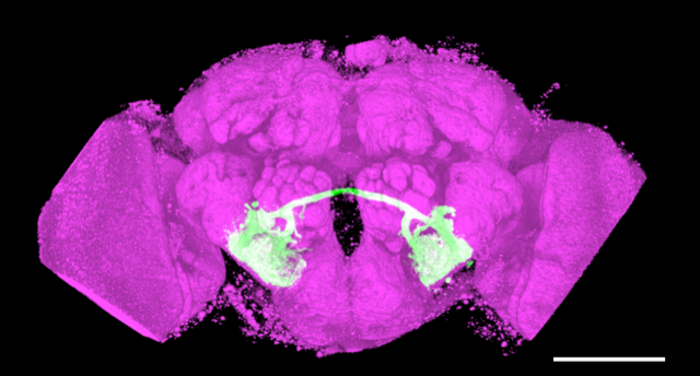When it comes to courtship, it is important to ensure that one is interacting with a member of the same species. Animals use multiple sensory systems to confirm that potential mates are indeed suitable, with acoustic communication playing an important role in their decision making.

Credit: Takuro S. Ohashi
When it comes to courtship, it is important to ensure that one is interacting with a member of the same species. Animals use multiple sensory systems to confirm that potential mates are indeed suitable, with acoustic communication playing an important role in their decision making.
Although these differences have previously been reported at the behavioral level, it is not known how the neuronal circuitry underlying this decision-making has diverged between species. Now, in a new publication in Scientific Reports, a research group at Nagoya University in Japan has investigated how the auditory processing pathway has evolved and diverged between fruit fly species.
Males of several species of Drosophila (fruit flies), which are regularly used in neuroscience research, vibrate their wings rhythmically during courtship, producing a courtship song. The temporal components of these songs differ between species, allowing female flies to distinguish between potential mates.
“Identifying complex features, such as rhythm, requires information processing that involves not only the auditory organs but also neural circuits,” explains Yuki Ishikawa, the lecturer leading the project. “However, interspecies comparisons of the mechanism of rhythm discrimination have not been studied before because they require a more precise approach than just studying peripheral auditory organs.”
To find out what happens in the neural circuits during courtship, Professor Azusa Kamikouchi, Lecturer Yuki Ishikawa, and Graduate Student Takuro Ohashi of the Graduate School of Science first played songs with different rhythms to females of two closely related species of fruit flies (Drosophilia melanogaster and Drosophilia simulans), which have different courtship songs, to see which tones the females found acceptable. Confirming previous reports, the researchers found that Drosophilia simulans females preferred songs with distinct temporal components to those of Drosophilia melanogaster.
Building on these behavioral data, the researchers next used calcium imaging to determine how a specific subset of auditory neurons, called AMMC-B1, responded to different courtship songs between the species. They found that the responses of these neurons did indeed differ between species, and that these differences were consistent with previously observed behavioral responses.
“This is the first study to clarify how the evolution of the mechanism for distinguishing between rhythms of the same sound occurs,” explains Dr. Ishikawa. “Rhythmic information processing in neural circuits differs between fruit fly species. Using mathematical modeling, we have shown that this species difference may be due to a change in the balance between facilitation and inhibition in neural circuits.”
Despite the differences at the behavioral level, the group found that the overall characteristics of AMMC-B1 neurons are similar between the two species. This suggests that the properties of the neural circuit, at least in its early stages, are evolutionarily conserved. Thus, even in different species, they appear to be encoded by similar genes. These findings support the theory that the species-specificity of such neuronal cell groups emerged at a later stage of the auditory information- processing neural circuits.
“Drosophila melanogaster has neural mechanisms that are widely shared among animals,” Ishikawa said. “It is one of the most advanced animals for brain research because of the wealth of existing genetic tools. By introducing these tools into Drosophila simulans, this study was the first to make detailed interspecies comparisons of auditory neural circuits. By transferring these methods and results to closely related species, we can begin to study how information processing has evolved in the animal brain. We hope that the method established in this study will contribute to understanding the full picture of how mechanisms in the auditory brain have evolved.”
Journal
Scientific Reports
DOI
10.1038/s41598-022-27349-7
Article Title
Evolutionary conservation and diversification of auditory neural circuits that process courtship songs in Drosophila
Article Publication Date
7-Jan-2023




